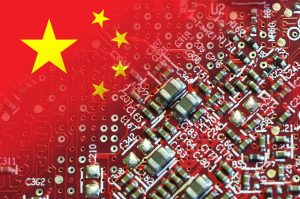The Diplomat author Mercy Kuo regularly engages subject-matter experts, policy practitioners, and strategic thinkers across the globe for their diverse insights into U.S. Asia policy. This conversation with Dr. Chris Miller – associate professor at the Fletcher School at Tufts University, Jeane Kirkpatrick Visiting Fellow at the American Enterprise Institute, and author of “Chip War: The Fight for the World’s Most Critical Technology” (Scribner 2022) – is the 347th in “The Trans-Pacific View Insight Series.”
Examine the “chip war” in the context of the China-U.S. tech war and, more broadly, China-U.S. rivalry.
Policymakers in both Beijing and Washington increasingly see semiconductors as crucial to the rivalry between the two countries. For China, this is an issue of strategic vulnerability, as China today is hugely reliant on the import of chips from geopolitical competitors like Taiwan, Japan, and the U.S. For Washington, meanwhile, China’s advances in chipmaking threaten the qualitative military advantages that have undergirded U.S. military power for decades. China will almost certainly outmatch the U.S. when it comes to number of systems deployed in contested theaters like the Taiwan Straits. So, the U.S. strategy is to stay ahead of China in terms of computing capabilities and hope that this edge in computing power translates into more capable military systems.
What are the key components of “supply chain statecraft”?
Companies think of supply chains in terms of efficiency, but governments think about politics. For decades, governments on both sides of the Pacific have seen supply chains as tools to achieve their political goals. As early as the 1950s, U.S. policymakers embraced the idea of assembling U.S. designed electronic devices in Asia as a means to bind Asian allies more closely to the U.S. by providing an avenue for economic growth. From Singapore to Taipei, political leaders in Asia saw plugging into U.S.-centric supply chains as a strategy not only to attract good jobs, but also to increase their importance to America and strengthen their confidence that the U.S. would guarantee their security in case of a crisis.
How might a cross-strait conflict impact Taiwan’s semiconductor industry?
Any large-scale conflict in the Taiwan Straits would disable if not completely destroy Taiwan’s chip industry. The idea that China could attack Taiwan and seize its fabs unharmed is fanciful. More worrisome, in my view, is that the military balance continues to shift in China’s favor, and that Beijing begins salami-slicing its way through Taiwanese autonomy – for example, by seizing an offshore island or by implementing a partial blockade. The U.S. might struggle to respond effectively, which could undermine Taiwan’s ability to mount a successful defense against a more dramatic move.
Evaluate U.S. handling of Huawei and its repercussions for China’s civil-military fusion apparatus.
The U.S. pressure campaign against Huawei provided an initial demonstration of many of the techniques the U.S. has rolled out in larger fashion to restrain China’s technological advantages. The decision to cut Huawei off from access to advanced chips has caused immense difficulties at the company, which has had to jettison entire business units. Huawei is playing a much more limited role in the rollout of 5G telecom infrastructure globally than would otherwise be the case. Moreover, the restrictions on Huawei demonstrated that China has few short-term remedies for its leading firms getting cut off from U.S. chip technology.
Assess the long-term implications of the U.S. Commerce Department’s broad-sweeping export control policy on AI and semiconductors to China and its impact on the global semiconductor industry.
I suspect the U.S. restrictions will be partially effective at preventing the transfer of advanced GPUs to China and fairly effective at dramatically slowing China’s advance toward leading edge logic chipmaking. If so, these controls will increase the cost to China of pursuing advanced computing capabilities, and the cost will grow over time as China’s ability to procure chips lags behind other countries.
China is likely to respond by pursuing more indigenization of its chipmaking capabilities, intensifying the trend of bifurcation of the semiconductor industry into “PRC” and “non-PRC” supply chains.

































